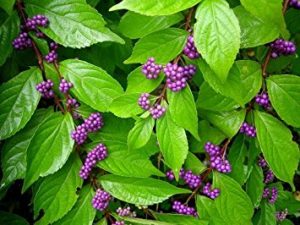Autumn infuses us with a new burst of energy. The brisk weather draws us outside to revel in the fresh air, clear skies, warm light and glowing colors. Images of vibrant fall landscapes often feature the chrysanthemums and deciduous trees (birches, dogwoods, maples, oaks and pears) that add so much color to an autumn scene. Although sometimes overlooked, shrubs also help create that beautiful blaze of color. Deciduous shrubs add shades of gold, orange, red and purple while evergreen shrubs contribute by providing the contrast that sets off those gorgeous colors!
Burning Bush (Euonymous alata) is a shrub that tops most lists for fall color. This shrub’s green foliage fairly ignites with red after a few cold nights. Although familiar, burning bush will always be a favorite among landscapers and homeowners. It grows easily in both woodland and coastal settings and is lovely in four seasons with soft green spring and summer leaves, that great fall color, and interesting winter bark. The dwarf form, “compactus,” can be pruned as a foundation planting or allowed some height and width in a more spacious area. For tight spots such as corners and walkways or inside perennial planting beds, a burning bush can be pruned up from the ground into a “tree-form.”
Oddly enough, the North American native, Viburnum, has never gained such widespread popularity. There are more than 200 know species in this lovely genus of small trees and shrubs. Although many of them will tolerate full sun, viburnums usually prefer wooded settings with light shade and moist, well-drained slightly acidic soil. Most of them have delicate white spring flowers (some with breathtaking scents) and fleshy berries (some brilliantly colored like scarlet jewels) that birds love. Two of the most popular viburnums are V. opulus (European cranberry bush) and V. trilobum (American cranberry bush). Both grow to the proportions of a small tree (8’ – 12’), have maple-like leaves, wide white clusters of spring flowers, beautiful scarlet berries, and lovely purple-red fall leaves. Both varieties have a dwarf cultivar (“Nanum”) that grows to about three feet. The American cranberry bush’s leaves are a bit smoother and more delicate than the European, and its fruit makes good jelly.
Another especially lovely viburnum is V.plicatum var.tomentosum. Familiar to many gardeners from the pages of Spring Hill Catalogues, this “Doublefile” or “Shasta” viburnum is an 8-10 ft. shrub that has creamy-white spring flowers along the entire length of each branch. It too has red fruit and brilliant red-purple autumn leaves.
Callicarpa spp., known as Beautyberry, is another North American native grown for its fall color. In this case, however, it’s not the toothed leaves, but the clusters of bright purple berries that jazz up the landscape while they attract appreciative birds. Depending on the variety, Beautyberry can be a low-growing, 2’-4’ shrub (C. dichotoma, “Purple Beautyberry”) or much larger, 5’-8’ shrub (C. americana, “French Mulberry”). Although most often sold as a purple berried shrub, some varieties of Beautyberry have snowy white berries. 
Aronia arbutifolia, or Red Chokeberry, is yet another North American native with perhaps the most brilliant red leaves and berries of all. In addition to its wonderful color, this easygoing shrub tolerates both wet and dry conditions! Chokeberries work well in a naturalized mass planting and their winter persisting berries create another great food source for hungry wildlife.
So, when you appreciate the color this fall, remember to look up at the glowing trees, down at the brilliant flowers and all around at those glorious shrubs in between!